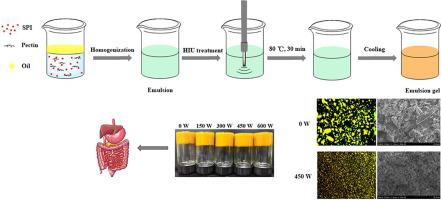Ultrasonics Sonochemistry ( IF 8.4 ) Pub Date : 2021-09-16 , DOI: 10.1016/j.ultsonch.2021.105756 Xin Zhang 1 , Xing Chen 1 , Yuhang Gong 1 , Ziyue Li 1 , Yanfei Guo 1 , Dianyu Yu 1 , Mingzhe Pan 1

|
In this study, soybean protein isolate (SPI) and pectin emulsion gels were prepared by thermal induction, and the effects of high intensity ultrasound (HIU) at various powers (0, 150, 300, 450 and 600 W) on the structure, gel properties and stability of emulsion gels were investigated. Fourier transform infrared spectroscopy (FTIR) and X-ray diffraction (XRD) showed that the interaction between SPI and pectin was enhanced and the crystallinity of the emulsion gels was changed due to the HIU treatment. Confocal laser scanning microscopy (CLSM) and scanning electron microscopy (SEM) observations revealed that the particle size of the emulsion gels was decreased significantly by HIU treatment. The emulsion gel structure became more uniform and denser, which was conducive to storage stability. In addition, according to the low field nuclear magnetic resonance (LF-NMR) analysis, HIU treatment had no obvious impact on the content of bound water as the power increased to 450 W, while the content of free water decreased gradually and became immobilized water, which indicated that the water holding capacity of the emulsion gels was enhanced. Compared with untreated emulsion gel, differential scanning calorimetry (DSC) analysis showed that the denaturation temperature reached 131.9 ℃ from 128.2 ℃ when treated at 450 W. The chemical stability and bioaccessibility of β-carotene in the emulsion gels were improved significantly after HIU treatment during simulated in vitro digestion.
中文翻译:

由大豆分离蛋白和果胶稳定的乳液凝胶:高强度超声对凝胶特性、稳定性和 β-胡萝卜素消化特性的影响
本研究通过热诱导制备大豆分离蛋白 (SPI) 和果胶乳液凝胶,并研究了不同功率 (0、150、300、450 和 600 W) 的高强度超声 (HIU) 对其结构、凝胶的影响研究了乳液凝胶的性质和稳定性。傅里叶变换红外光谱(FTIR)和X射线衍射(XRD)表明,由于HIU处理,SPI和果胶之间的相互作用增强,乳液凝胶的结晶度发生变化。共聚焦激光扫描显微镜 (CLSM) 和扫描电子显微镜 (SEM) 观察表明,HIU 处理显着降低了乳液凝胶的粒径。乳液凝胶结构更加均匀致密,有利于储存稳定性。此外,根据低场核磁共振(LF-NMR)分析,随着功率增加到 450 W,HIU 处理对结合水的含量没有明显影响,而游离水的含量逐渐减少并变成固定水,这表明表明乳液凝胶的保水能力得到增强。与未经处理的乳液凝胶相比,差示扫描量热(DSC)分析表明,450 W 处理时的变性温度从 128.2 ℃ 达到 131.9 ℃。HIU 处理后乳液凝胶中 β-胡萝卜素的化学稳定性和生物可及性显着提高。模拟的 而游离水的含量逐渐减少,成为固定水,表明乳液凝胶的持水能力增强。与未经处理的乳液凝胶相比,差示扫描量热(DSC)分析表明,450 W 处理时的变性温度从 128.2 ℃ 达到 131.9 ℃。HIU 处理后乳液凝胶中 β-胡萝卜素的化学稳定性和生物可及性显着提高。模拟的 而游离水的含量逐渐减少,成为固定水,表明乳液凝胶的持水能力增强。与未经处理的乳液凝胶相比,差示扫描量热(DSC)分析表明,450 W 处理时的变性温度从 128.2 ℃ 达到 131.9 ℃。HIU 处理后乳液凝胶中 β-胡萝卜素的化学稳定性和生物可及性显着提高。模拟的体外消化。


























 京公网安备 11010802027423号
京公网安备 11010802027423号